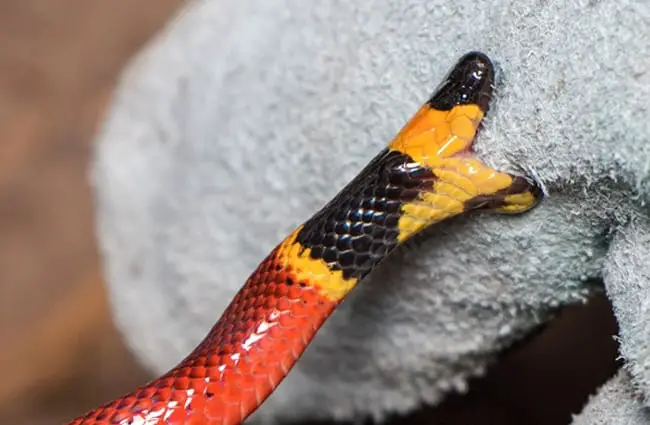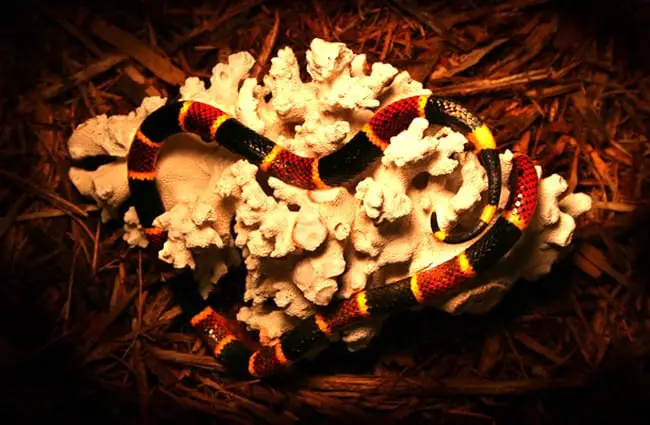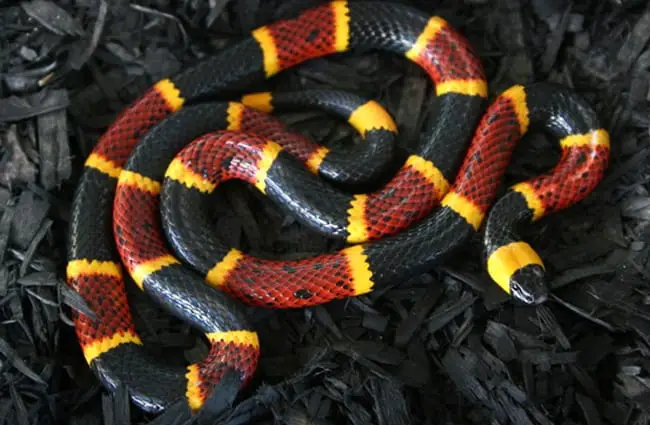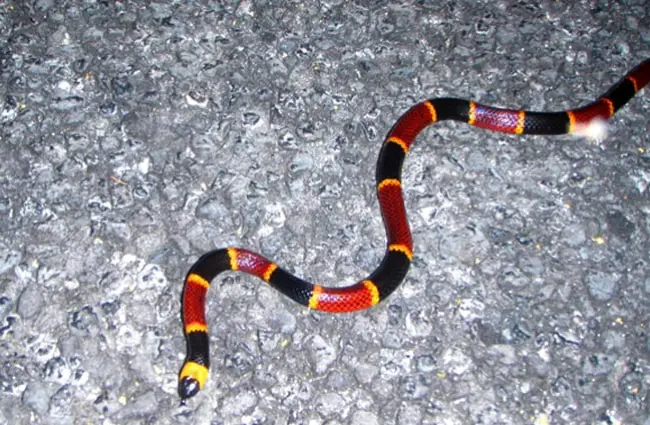The natural world is full of vibrant warnings, and few are as striking or as misunderstood as the coral snake. With its dazzling bands of red, yellow, and black, this serpent is a living billboard, signaling both danger and a fascinating evolutionary story. Often shrouded in myth and fear, the coral snake is a creature of immense scientific interest, playing a unique role in its ecosystems and offering valuable lessons in biology and behavior.

Unmasking the Coral Snake: Identification and Venom
For many, the coral snake is defined by a simple rhyme, a mnemonic device designed to distinguish it from its harmless mimics: “Red on yellow, kill a fellow; red on black, venom lack.” This adage refers to the arrangement of the colored bands. In true coral snakes found in North America, the red bands always touch the yellow bands. This distinct pattern is a crucial identifier, though it is important to note that this rhyme primarily applies to species within the United States and Canada. Other coral snake species in Central and South America may have different patterns, making local knowledge paramount.
Physical Characteristics
Coral snakes are relatively small, slender snakes, typically ranging from 20 to 30 inches (50 to 75 cm) in length, though some individuals can exceed 4 feet (1.2 meters). Their heads are small and blunt, almost indistinguishable from their necks, lacking the broad, triangular head often associated with many other venomous snakes. Their eyes are also small and dark. The body is covered in smooth, glossy scales, giving them a sleek appearance. The vibrant banding pattern serves as aposematic coloration, a warning to potential predators of their toxicity.
The Nature of Their Venom
Coral snakes belong to the Elapidae family, a group that includes cobras and mambas. Their venom is primarily neurotoxic, meaning it attacks the nervous system. Unlike the hemotoxic venom of vipers, which causes immediate pain, swelling, and tissue damage, coral snake venom can have a delayed onset of symptoms, sometimes hours after a bite. Once symptoms begin, they can progress rapidly, leading to muscle weakness, slurred speech, double vision, difficulty breathing, and eventually respiratory or cardiac arrest if left untreated. Despite their potent venom, bites are rare and often occur when people attempt to handle them. Their fangs are small and fixed, requiring a chewing motion to effectively inject venom, which is another reason bites are less common than with vipers.

Where the Wild Things Are: Habitat and Distribution
Coral snakes are primarily found in the Americas, with species distributed from the southern United States through Central and South America. In the U.S., they inhabit a range stretching from the Carolinas, across the Gulf Coast states, and into Arizona. Each region hosts specific species, such as the Eastern Coral Snake (Micrurus fulvius) in the southeastern U.S. and the Western Coral Snake (Micruroides euryxanthus) in the southwestern U.S.
Preferred Environments
These snakes are masters of camouflage and discretion, preferring habitats that offer plenty of cover. They are often found in sandy areas, pine forests, scrublands, and even suburban gardens, particularly those with loose soil, leaf litter, or decaying logs. Their fossorial (burrowing) nature means they spend a significant portion of their lives underground or hidden beneath debris, emerging primarily at dawn and dusk (crepuscular) or during the night (nocturnal). This reclusive behavior is a key reason why encounters with humans are relatively infrequent. An animal lover hoping to spot one in the wild would need patience and a keen eye, focusing on turning over logs or rocks in suitable habitats, always with caution.

A Hunter in Hiding: Diet and Predation
The coral snake’s diet is specialized, primarily consisting of other snakes and lizards. They are ophiophagous, meaning “snake-eaters,” and will readily consume small, slender snakes, including other venomous species, as well as various lizards. Their hunting strategy involves ambushing prey, delivering a venomous bite, and then holding on until the neurotoxin takes effect, paralyzing the victim. This specialized diet highlights their unique position within the food web, acting as a significant predator of other reptiles.

The Cycle of Life: Mating and Reproduction
Coral snakes are oviparous, meaning they lay eggs. The mating season typically occurs in the spring, with females laying a clutch of 3 to 12 elongated, leathery eggs in late spring or early summer. These eggs are usually deposited in hidden, damp locations such as under logs, in leaf litter, or within decaying vegetation. The incubation period lasts approximately 60 to 90 days, after which tiny, brightly colored hatchlings emerge, miniature versions of their parents, complete with fully functional venom glands. These young snakes are immediately independent and capable of hunting small prey.

Ecosystem Contributions and Interactions
Despite their venomous nature, coral snakes are an integral part of their ecosystems. As predators of other snakes and lizards, they help regulate populations of these animals, contributing to the overall balance of their habitats. Their presence can also influence the behavior and distribution of their prey species. Furthermore, their distinctive coloration has led to fascinating evolutionary interactions, particularly with non-venomous mimics like kingsnakes. These mimics benefit from the coral snake’s dangerous reputation, deterring predators who associate the “red on yellow” pattern with a painful encounter. This phenomenon, known as Batesian mimicry, underscores the coral snake’s significant, albeit indirect, contribution to the survival of other species.
Living Alongside Humans: Encounters and Safety
Encounters between coral snakes and humans are relatively uncommon due to the snake’s reclusive nature. However, when they do occur, it is crucial to understand how to react. A hiker encountering a coral snake should always maintain a safe distance and never attempt to handle, harass, or kill the snake. Most bites happen when people try to pick them up or step on them inadvertently. The snake’s primary defense is to flee, but if cornered, it will bite.
What to Do in Case of a Bite
If a bite occurs, immediate medical attention is paramount. The affected limb should be immobilized and kept below the level of the heart. Remove any constricting jewelry or clothing. Do not attempt to cut the wound, apply a tourniquet, or try to suck out the venom. These actions are ineffective and can cause more harm. Transport the individual to the nearest medical facility as quickly as possible, where antivenom can be administered. Fortunately, antivenom for coral snake bites is effective, though its availability can sometimes be limited.
Cultural Significance
In human culture, the coral snake often evokes a mix of fear and fascination. Its striking colors have made it a symbol of danger, but also of beauty and the wild. While not as prominent in folklore as some larger, more aggressive snakes, its unique warning pattern has cemented its place in popular consciousness, particularly through the widely known identification rhyme.
Deeper Dives: For the Aspiring Zoologist and Zookeeper
Venomology and Evolution
The neurotoxic venom of coral snakes is a complex cocktail of proteins and enzymes. These toxins primarily target the neuromuscular junctions, blocking the transmission of nerve signals to muscles. This leads to progressive paralysis, affecting vital functions like breathing. The evolutionary history of coral snakes places them firmly within the Elapidae family, suggesting a shared ancestry with other highly venomous snakes found across the globe. Their specialized venom delivery system, with small, fixed fangs, is a key characteristic of this family, distinguishing them from the retractable fangs of vipers. Studying coral snake venom has provided valuable insights into neurobiology and potential therapeutic applications.
Conservation Status
Most coral snake species are not currently considered endangered, though localized populations can face threats from habitat destruction and fragmentation. Their secretive nature makes accurate population assessments challenging. Maintaining healthy, undisturbed habitats with ample cover is crucial for their continued survival.
Captive Care Considerations for Zookeepers
Caring for coral snakes in captivity requires specialized knowledge and strict safety protocols. Zookeepers must prioritize the safety of both the animal and themselves.
- Enclosure: A secure, escape-proof terrarium is essential. Coral snakes are fossorial, so a deep substrate of sand, cypress mulch, or a sand-soil mix is necessary to allow for burrowing. Hiding spots, such as cork bark or artificial caves, should also be provided.
- Temperature and Humidity: Maintaining appropriate temperature gradients (typically 75-85°F or 24-29°C) and moderate humidity is crucial. A shallow water dish should always be available.
- Diet: In captivity, coral snakes are typically fed small, pre-killed snakes or lizards. Some individuals may be coaxed to eat appropriately sized rodents, but this is less common. Feeding frequency depends on the snake’s size and age.
- Handling: Direct handling of coral snakes should be avoided whenever possible due to their potent venom. When necessary for enclosure maintenance or veterinary care, specialized tools such as snake hooks and clear plastic tubes or containers should be used to safely restrain and transfer the snake. Two-person handling protocols are often recommended.
- Veterinary Care: Regular health checks are important. Zookeepers should be aware of the nearest facility stocking coral snake antivenom in case of an accidental bite, though prevention is the best strategy.
Fascinating Facts and Common Misconceptions
- Small Mouth, Big Bite: A common myth is that coral snakes cannot bite humans effectively due to their small mouths and rear-fixed fangs. This is false. While they may need to chew to deliver venom, they are perfectly capable of inflicting a dangerous bite.
- Tail Display: When threatened, some coral snakes will coil their tails and raise them, sometimes even mimicking their head, to confuse predators about which end is which.
- Longevity: In the wild, coral snakes can live for several years, and in well-managed captive environments, they can live for over a decade.
- Nocturnal Hunters: Their preference for hunting at night or during twilight hours contributes to their elusive nature and fewer human encounters.
The coral snake, with its vibrant warning colors and potent venom, is a testament to the intricate beauty and danger of the natural world. From its role as a specialized predator to its evolutionary dance with mimics, this snake offers endless avenues for study and appreciation. Understanding and respecting these fascinating creatures is key to coexisting with them and ensuring their place in our planet’s rich biodiversity.

![Red Angus Closeup of a beautiful Red Angus cowPhoto by: U.S. Department of Agriculture [pubic domain]https://creativecommons.org/licenses/by/2.0/](https://animals.net/wp-content/uploads/2020/03/Red-Angus-4-238x178.jpg)




![Red Angus Closeup of a beautiful Red Angus cowPhoto by: U.S. Department of Agriculture [pubic domain]https://creativecommons.org/licenses/by/2.0/](https://animals.net/wp-content/uploads/2020/03/Red-Angus-4-100x75.jpg)

